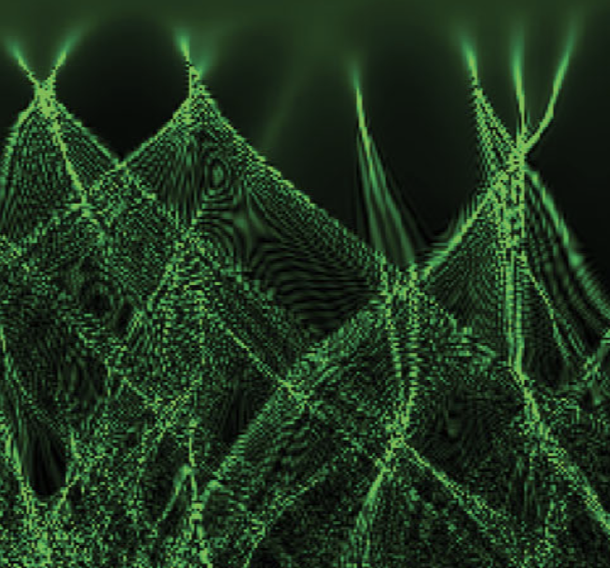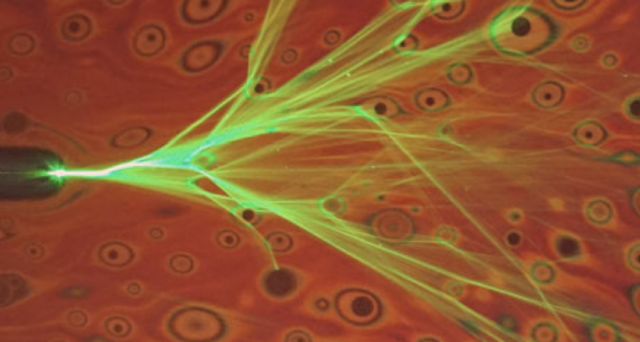
Science is often viewed as utilitarian. We explore the natural world so that we can plunder its secrets for our own benefit. Indeed, this is often precisely the sort of science that funding agencies seek. But, for most scientists, the utilitarian comes second to other motivating factors: The observation of beauty and the challenge of a unique puzzle are the two that spring to mind. Today, in the spirit of observing beauty, I’d like you to sit back and enjoy the view of light flowing like water.

The picture above looks like a river delta, with many tributaries and rivulets coming together in one Amazonian outflow. All that is missing is the fish. But that is light flowing out of an optical fiber and into a layer of soap. The soap layer traps the light, so it only spreads out in the plane of the soap. Yet the layer is also uneven, so the light cannot spread out evenly, and you get this branching pattern. This is one of the pictures from a group of scientists exploring how light flows in thin films.
The making of an optical river
To create an optical river, you need to do the following: start with a nice flat surface and place a layer of detergent (soapy water) with a tiny bit of dye in it. After some time (and given the right mixture of soap), the soap film will settle down so that it is not moving around. Then, shine some light on the edge of the soap layer. If you get the focusing conditions just right, the light will be trapped within the soap layer. The light will then start to spread out across and through the soap, exiting from other edges.
From above (as in the picture), you will see very little because the light is confined within the layer. This is where the dye comes in. When light hits the dye molecules, they will also glow. But, the glow from the dye molecules can go in any direction, including upward toward your waiting camera. Even more nicely, the more light that hits the dye, the brighter it will glow. This means that your picture from above is exactly like a picture of a river delta: the fat bright areas correspond to lots of light flowing through that area, while dark areas are optically dry land.
The researchers have set up a very clever experiment. The soap layer is irregular: Some areas are thicker than others. When light encounters a change in thickness, it scatters (changes direction). In this picture, the movement of light is exactly analogous to water flow. Water flows around the slightly raised area, creating two streams.
But, unlike water (which is oppressed by gravity), light also has the option of shooting straight up out of the soap layer (scattering happens in all three dimensions). However, this does not happen much because the soap layer irregularities hit a sweet spot between not doing much scattering and scattering so strongly that the light leaves the soap film. Think of it as gently guiding a line of drunk photons around patrons at a bar, as opposed to letting the patrons smack each photon on the head and send it reeling off in a new direction, only to be swatted away again.
But, why does light flow like this?
Even then, the flow of light is still different from the flow of water. Light is a wave, and waves can interfere with each other. To go back to our soap layer, imagine a wave of light being split into two by an irregularity in the soap film. Later on, those two waves encounter each other again. If the waves are in synchrony with each other, then they will add up to a brighter light that continues on. However, if they are out of sync with each other, they will add up to a dimmer light, meaning that the light will flow elsewhere.
The researchers explored how the wave-like aspect of light changed the flow of light. In its essentials, when light flows like a river, the wave-like aspects change the details but not the overall behavior. Essentially, the interference of waves makes the bright areas brighter and sharper, while the dark areas become darker. Removing the influence of interference simply smears out the light, making the delta look a little more flooded and a little less confined to sharp channels. You can see the difference in the two pictures below.

I’m sure that if asked, the researchers can come up with applications for this. Hell, if I took my brain out of neutral, I might be able to come up with applications. But I don’t really care; I just want to bathe in the river of light.
Physical Review X, 2022, DOI: 10.1103/PhysRevX.12.021007 (About DOIs)
reader comments
26